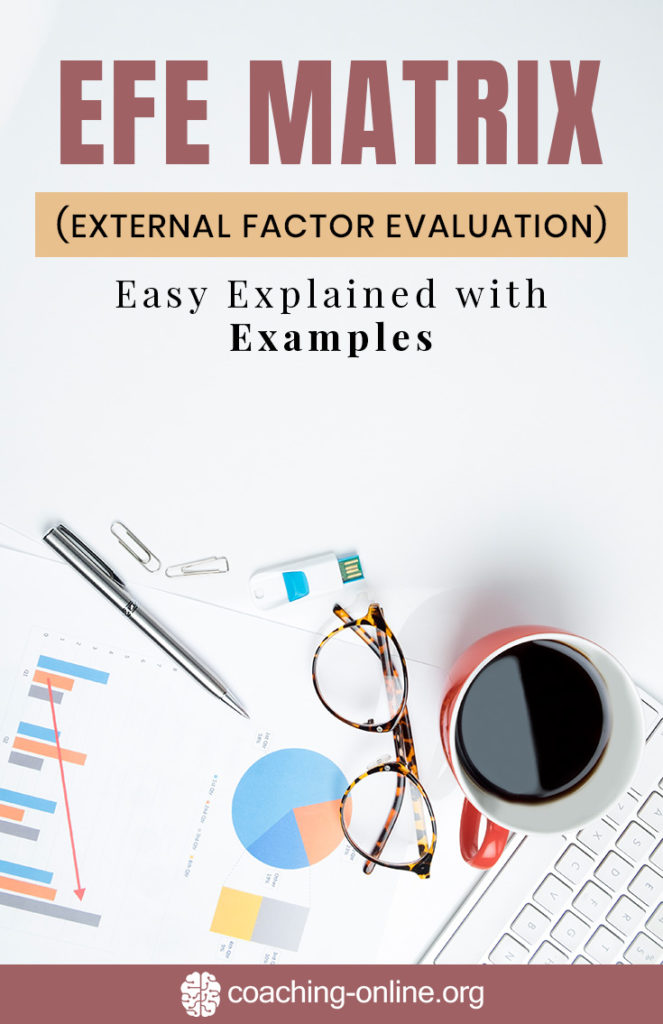An EFE matrix is an evaluation tool that can help you grow your business.
This tool is rapid, easy to use, and can help you quickly get an edge over your competitors.
In this guide, I explain what an EFE matrix is and how to use it to maximize your company’s profits.
Let‘s dive right in.
What is an EFE Matrix?
An External Factor Evaluation (EFE) Matrix is a strategic tool used by businesses to evaluate their current strategies.
It does this by considering the key external factors in a company´s environment that may affect its performance.
These factors may be, among others:
- Competitive
- Economic
- Legal
- Social
- Political
- Technological

What Are the Five Steps to Develop an EFE Matrix?
1. List the External Factors and Categorize Them as Opportunities or Threats
The key external factors should be extracted from a previous deep analysis of the external environment, such as a PEST or SWOT analysis.
They may include trade agreements, supply chain issues, information on competitors, market fluctuations, new legislation, and much more.
Once identified, categorize the key external factors as either “opportunities” or “threats”. Consider which factors could potentially benefit or harm your company.
The opportunities are areas in which the company has the chance to take advantage of and potentially increase their market share.
The threats are any external factor which could potentially negatively impact the company and reduce their market share.
Deciding whether a factor is an opportunity or a threat is subjective. Sometimes, the same external factor can represent both an opportunity and a threat!
It is also important to consider your competitors and how they may respond to the same external environment.
This will give you an idea of whether their current strategies are effective or not.
2. Assign a Weight to Each Factor
Once you have identified the opportunities and threats, you must assign them weighted scores.
This is an important step because not all external factors will impact your business equally.
Weights are subjective, but you can base them on the analysis of industry experts. Find out what they consider the most important factors for success in your sector, then assign the weights accordingly.
To do this, assign a weight to each factor based on its importance, ranging from 0 (not important) to 1.0 (most important). The sum weight of all the factors must be equal to 1.0.

3. Assign a Rating
The ratings you assign to each external factor should reflect how effectively the firm‘s current strategies respond to the opportunities and threats.
These must be assigned by you and your team, based on your own analysis of current strategies.
The ratings range from one to four for each external factor. The rating of each factor shows how effectively the company’s strategies respond to each opportunity or threat, as follows:
4 = excellent response
3 = above-average response
2 = average response
1 = poor response
4. Determine the Weighted Scores
To determine the weighted score for each of the external factors, simply multiply its weight by its rating.
5.Total Weighted Score
To find the total weighted score, simply add all the weighted scores together. The total weighted score should range between 1 and 4.
The total weighted score of the EFE matrix is only part of the picture. The analysis of the key external factors should be combined with the analysis of the key internal factors using the IFE matrix.
After analyzing both the internal and external environment, the company can develop new strategies that will help it grow and become more competitive.

External- vs. Internal Factor Evaluation Matrix
The difference between an external factor evaluation (EFE) and an internal factor evaluation (IFE) Matrix is that the EFE considers external factors and classifies them as opportunities and threats, while an IFE matrix considers the company’s key internal factors.
The internal factors may include aspects such as:
- Organizational structure
- Profit margins
- Diversity of client base
- Company debt
- Reputation
- Market competitiveness…
…and many others. This exercise is more subjective, so it’s up to you and your team to thoroughly identify the key internal factors.
Once identified, you must then classify each of the internal factors as either strengths or weaknesses.
As with the EFE matrix, you then assign a weight and rating to each of the factors. Once this is done, multiply the weight by the rating to give each factor a weighted score.
The total weighted score will reveal the reality of the firm’s internal environment and its capacity to respond to opportunities and threats in the external environment.
Once the EFE matrix and IFE matrix have been developed, it’s up to the management team to redesign their strategies to effectively respond to the external and internal environments.
What Is a Good EFE Matrix Score / IFE Matrix Score?
An average total weighted score is 2.5 in both the EFE matrix and IFE matrix.
In the EFE matrix, a low score indicates that the company’s current strategies are not designed to take advantage of opportunities or defend it against threats.
A high score indicates that the strategies are well adapted to the current external environment.
In the IFE matrix, a low score indicates that the firm is weak in comparison with its competitors. A high score indicates it is one of the strongest in its sector.
Example of an External Factor Evaluation (EFE) Matrix
| Key external factors | Weight | Rating | Weighted Score |
| Opportunities | |||
| Signing a contract with a new supplier | 0.11 | 3 | 0.33 |
| Industry consolidation | 0.9 | 1 | 0.09 |
| Market predicted to grow by 15% | 0.24 | 2 | 0.48 |
| Growth of low-cost sector | 0.10 | 1 | 0.10 |
| Threats | |||
| New tax imposed by government | 0.17 | 4 | 0.68 |
| Economic crisis | 0.14 | 3 | 0.42 |
| Declining margins | 0.12 | 2 | 0.24 |
| Competitors increasing market share | 0.03 | 2 | 0.06 |
| Total | 1 | – | 2.40 |
In this example of an EFE matrix, the company has a score of 2.4.
This is an average score, which means the current strategies are neither effective or ineffective at taking advantage of the opportunities or defending the firm against threats.

So, there you have it. A simple guide to using the EFE matrix and IFE matrix.
Thanks for stopping by and reading my guide. Share this piece with a friend to help them too!
Related Content
Best Executive Leadership Coaching Online
Career Coach – What You Need to Know
